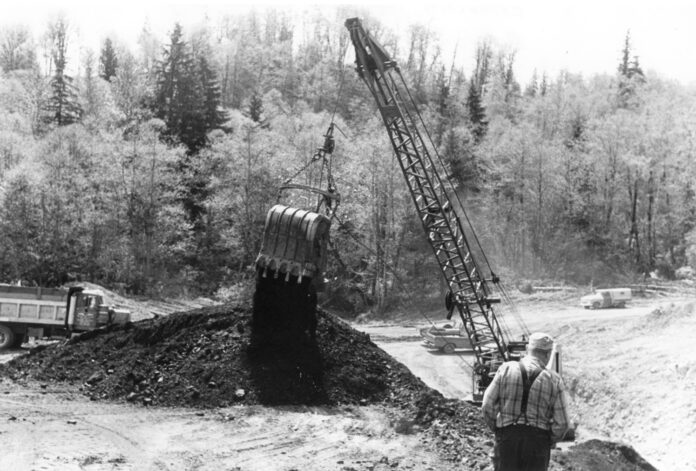In December 1975, when Palmer Coking Coal closed Washington State’s last underground coal mine, the company still had contracts to supply coal to several state institutions. Those four facilities were heated by coal. The Washington Correction Center near Shelton and the Monroe Reformatory in Monroe were supplied with Palmer’s stoker coal, as were the State Soldiers Home in Orting and the Maple Lane School, a youth detention facility in Centralia. With the Rogers No. 3 underground mine no longer producing coal, Palmer’s management turned to surface mining on Franklin Hill, about two miles east of downtown Black Diamond.
At the time of this April 1977 photo, more than 95% of Palmer’s 20,000 ton annual output was sold to Washington State facilities. In the shadow of the 1973-74 Arab oil embargoes, local utilities began looking at coal to supplement Washington’s primary energy source – hydroelectricity. In Feb. 1977, Seattle City Light budgeted $2.5 million to hire Shannon & Wilson, who were working in consultation with Kaiser Engineering for preliminary drilling and exploratory work to determine the feasibility of using the vast coal reserves in Black Diamond and Roslyn to generate power.
Over the 90 years after Washington’s first coal mine was opened in 1853 near Bellingham, almost all of it was mined underground. Surface mining involved removing large amounts of geologic strata that lay over the dipping coal seams. It was impractical to move large quantities of earth utilizing horses and carts. Steam shovels could dig canals and build roads, but surface coal mining was a different kind of excavation.
However, in the years following World War II, thousands of pieces of heavy machinery such as diesel-powered bulldozers, shovels, and off-highway dump trucks were sold off cheaply as surplus equipment. In the local area, mining companies began extracting coal from outcrops along the surface. Overburden, primarily consisting of sandstone was drilled, blasted, and removed and in the process exposed thick veins of coal. While surface mining could only penetrate to depths of perhaps 100 feet, it still provided a cheaper and faster method of extracting coal with far fewer employees, plus few of the dangers associated with underground mining.
In this photo looking south towards Randolph Creek on Franklin Hill, Jack Kombol is operating a Koehring 405 dragline crane outfitted with an excavation shovel bucket to extract coal from the McKay seam. Discovery of the McKay bed in 1882 led to the establishment of two major mining towns, Black Diamond and Franklin. Sixteen years later in 1898, the Northern Pacific Railroad built a more direct rail route between Kanaskat and Auburn, so Ravensdale was born on that same lode of McKay coal.
A dump truck operated by Moulden Trucking is seen to the left, ready to be loaded with coal. To the right of the dragline, partially obscuring the Koehring crane whose bucket is dumping coal, stands Bill Petchnick, a retired coal miner observing the surface mining operation. Next week’s column features Petchnick at the controls of this same mine shovel with a sketch of his life as a coal miner.









